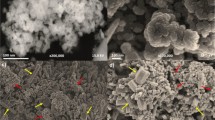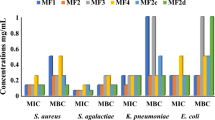Abstract
[Ru(II)(bpy)2(dppn)]2+ (bpy = 2,2′-bipyridine, dppn = 4,5,9,16-tetraazadibenzo[a,c]naphthacene) was found to be able to photoinactivate Gram-negative Escherichia coli efficiently, showing the potential of transition-metal complexes as photosensitizers in the field of photodynamic antimicrobial chemotherapy (PACT).
Similar content being viewed by others
References
H. C. Neu, The crisis in antibiotic resistance, Science, 1992, 257, 1064.
M. Wainwright, Photodynamic antimicrobial chemotherapy (PACT), J. Antimicrob. Chemother., 1998, 42, 13
S. Noimark, C. W. Dunnill, M. Wilson and I. P. Parkin, The role of surfaces in catheter-associated infections, Chem. Soc. Rev., 2009, 38, 3435.
M. R. Hamblin and T. Hasan, Photodynamic therapy: a new antimicrobial approach to infectious disease?, Photochem. Photobiol. Sci., 2004, 3, 436.
Z. Malik, H. Ladan and Y. Nitzan, Photodynamic inactivation of Gram-negative bacteria: problems and possible solutions, J. Photochem. Photobiol., B, 1992, 14, 262
R. Bonnett, D. G. Buckley, T. Burrow, A. B. B. Galia, B. Saville and S. P. Songca, Photobactericidal materials based on porphyrins and phthalocyanines, J. Mater. Chem., 1993, 3, 323.
M. Merchat, G. Bertoloni, P. Giacomoni, A. Villanueva and G. Jori, Meso-substituted cationic porphyrins as efficient photosensitizers of gram-positive and gram-negative bacteria, J. Photochem. Photobiol., B, 1996, 32, 153
M. R. Hamblin, D. A. O’Donnell, N. Murthy, K. Rajagopalan, N. Michaud, M. E. Sherwood and T. Hasan, Polycationic photosensitizer conjugates: effects of chain length and Gram classification on the photodynamic inactivation of bacteria, J. Antimicrob. Chemother., 2002, 49, 941
B. Hager, W. S. L. Strauss and H. Falk, Cationic hypericin derivatives as novel agents with photobactericidal activity: synthesis and photodynamic inactivation of propionibacterium acnes, Photochem. Photobiol., 2009, 85, 1201
D. O. Frimannsson, M. Grossi, J. Murtagh, F. Paradisi and D. F. O’Shea, Light induced antimicrobial properties of a brominated boron difluoride (BF2) chelated tetraarylazadipyrromethene, J. Med. Chem., 2010, 53, 7337.
K. E. Erkkila, D. T. Odom and J. K. Barton, Recognition and reaction of metallointercalators with DNA, Chem. Rev., 1999, 99, 2777
W. H. Ang and P. J. Dyson, Classical and non-classical ruthenium-based anticancer drugs: Towards targeted Chemotherapy, Eur. J. Inorg. Chem., 2006, 4003
B. M. Zeglis, V. C. Pierre and J. K. Barton, Metallointercalators and metalloinsertors, Chem. Commun., 2007, 4565.
H. Y. Mei and J. K. Barton, Tris(tetramethylphenanthroline) ruthenium(II): a chiral probe that cleaves A-DNA conformations, Proc. Natl. Acad. Sci. U. S. A., 1988, 85, 1339
Y. Liu, R. Hammitt, D. A. Lutterman, R. P. Thummel and C. Turro, Marked differences in light-switch behavior of Ru(II) complexes possessing a tridentate DNA intercalating ligand, Inorg. Chem., 2007, 46, 6011
Y. Liu, R. Hammitt, D. A. Lutterman, R. P. Thummel and C. Turro, Ru(II) complexes of new tridentate ligands: unexpected high yield of sensitized 1O2, Inorg. Chem., 2009, 48, 375
Q. X. Zhou, F. Yang, W. H. Lei, J. R. Chen, C. Li, Y. J. Hou, X. C. Ai, J. P. Zhang, X. S. Wang and B. W. Zhang, Ruthenium(II) terpyridyl complexes exhibiting DNA photocleavage: The role of the substituent on monodentate ligand, J. Phys. Chem. B, 2009, 113, 11521
Y. Sun, L. E. Joyce, N. M. Dickson and C. Turro, Efficient DNA photocleavage by [Ru(bpy)2(dppn)]2+ with visible light, Chem. Commun., 2010, 46, 2426.
T. Gianferrara, I. Bratsos and E. Alessio, A categorization of metal anticancer compounds based on their mode of action, Dalton Trans., 2009, 7588.
Q. X. Zhou, W. H. Lei, J. R. Chen, C. Li, Y. J. Hou, X. S. Wang and B. W. Zhang, A new heteroleptic ruthenium(II) polypyridyl complex with long-wavelength absorption and high singlet-oxygen quantum yield, Chem. Eur. J., 2010, 16, 3157
Q. X. Zhou, W. H. Lei, Y. Sun, J. R. Chen, C. Li, Y. J. Hou, X. S. Wang and B. W. Zhang, [Ru(bpy)3-n(dpb)n]2+: Unusual photophysical property and efficient DNA photocleavage activity, Inorg. Chem., 2010, 49, 4729.
C. A. Puckett and J. K. Barton, Methods to explore cellular uptake of ruthenium complexes, J. Am. Chem. Soc., 2007, 129, 46.
A. A. Abdel-Shafi, P. D. Beer, R. J. Mortimer and F. Wilkinson, Photosensitized generation of singlet oxygen from vinyl linked benzocrown-ether–bipyridyl ruthenium(II) complexes, J. Phys. Chem. A, 2000, 104, 192.
E. Reddi, M. Ceccon, G. Valduga, G. Jori, J. C. Bommer, F. Elisei, L. Latterini and U. Mazzucato, Photophysical properties and antibacterial activity of meso-substituted cationic porphyrins, Photochem. Photobiol., 2002, 75, 462.
X. Q. Guo, F. N. Castellano, L. Li and J. R. Lakowicz, A longlifetime Ru(II) metal–ligand complex as a membrane probe, Biophys. Chem., 1998, 71, 51
M. Ardhammar, P. Lincoln and B. Nordén, Ligand substituents of ruthenium dipyridophenazine complexes sensitively determine orientation in liposome membrane, J. Phys. Chem. B, 2001, 105, 11363.
A. E. Friedman, J. C. Chambron, J. P. Sauvage, N. J. Turro and J. K. Barton, A molecular light switch for DNA: Ru(bpy)2(dppz)2+, J. A m. Chem. Soc., 1990, 112, 4960.
C. A. Strassert, M. Otter, R. Q. Albuquerque, A. Höne, Y. Vida, B. Maier and L. D. Cola, Photoactive hybrid nanomaterial for targeting, labeling, and killing antibiotic-resistant bacteria, Angew. Chem., Int. Ed., 2009, 48, 7928
C. Xing, Q. Xu, H. Tang, L. Liu and S. Wang, Conjugated polymer/porphyrin complexes for efficient energy transfer and improving light-activated antibacterial activity, J. Am. Chem. Soc., 2009, 131, 13117.
G. Valduga, B. Breda, G. M. Giacometti, G. Jori and E. Reddi, Photosensitization of wild and mutant strains of Escherichia coli by meso-tetra (N-methyl-4-pyridyl)porphine, Biochem. Biophys. Res. Commun., 1999, 256, 84.
Author information
Authors and Affiliations
Corresponding author
Additional information
Electronic supplementary information (ESI) available: Experimental section; Table S1; Fig. S1–S7. See DOI: 10.1039/c0pp00275e
Rights and permissions
About this article
Cite this article
Lei, W., Zhou, Q., Jiang, G. et al. Photodynamic inactivation of Escherichia coli by Ru(II) complexes. Photochem Photobiol Sci 10, 887–890 (2011). https://doi.org/10.1039/c0pp00275e
Received:
Accepted:
Published:
Issue Date:
DOI: https://doi.org/10.1039/c0pp00275e




